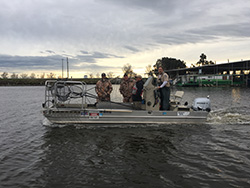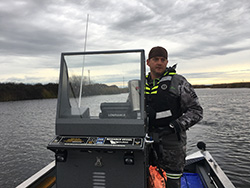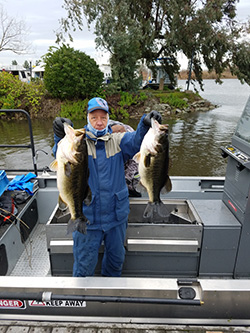
Joe Millosovich, an environmental scientist who specializes in lake and fisheries management in the Central Valley, came all the way from Fresno to captain one of the electrofishing boats collecting bass in the Delta Jan. 16. Several of CDFW’s biologists participating in the outing called it one of their favorite days of the year.

Max Fish, an environmental scientist with CDFW’s Inland Fisheries Program, captained the electrofishing boat that collected the largest largemouth bass of the morning – a 10-pound-plus whopper.

Kyle Murphy, a senior environmental scientist with CDFW’s Inland Fisheries Program, shows off two of the larger Delta largemouth bass headed for the International Sportsmen’s Exposition demonstration tank in Sacramento.
Among the more popular attractions at the Sacramento International Sportsmen’s Expo each January is the Western Bass Aquarium Demo Tank. The 6,000-gallon aquarium displays dozens of trophy largemouth bass collected by CDFW biologists from the Sacramento-San Joaquin Delta. The aquarium demo tank, with bleachers on both sides, is where professional bass anglers lead seminars demonstrating the latest techniques and can’t-miss lures – all without hooks attached so as not to injure the fish.
“This is the best display of largemouth bass anywhere in the country,” said Kent Brown, the longtime host of the ISE demonstration tank. “And that’s not just me talking. That’s from tournament bass fishermen who travel all over the country. There’s just no bass anywhere that can rival these Delta bass.”
The tank is also a tremendous source of pride for the CDFW fisheries biologists tasked with collecting the fish.
“It’s great for people to see the kind of fish they can catch here in their own backyard,” says Ben Ewing, a CDFW district fisheries biologist who headed the ISE collection effort this year. “All the fish get released back into the Delta immediately after the show and literally are available for anyone with a fishing license to catch.”
A mix of 16 fisheries biologists and volunteers assembled along the Delta near Stockton the morning of Jan. 16, the day before the opening of the four-day ISE show at Sacramento’s Cal Expo. They climbed onto four electrofishing boats to probe likely largemouth hideouts – tule stands, rip-rap shoreline, sunken boats, submerged tree limbs and other structure.
“We all come together to try and make a good display for the public,” Ewing said.
Over the years, a friendly competition has developed. A trophy and bragging rights go to the CDFW boat captain who collects the largest bass for the show. Each of the four captains took off with their crews in different directions searching for a largemouth bass that might not only win the day but one that might top their all-time ISE show record fish of more than 13 pounds.
The boats sent targeted currents of electricity through the water while crew members standing on the bow were ready with nets to scoop up the stunned fish for deposit into the live wells for safekeeping. In more than 20 years of providing Delta largemouth bass for the Sacramento ISE show, CDFW biologists have refined their methods and strategies.
In addition to looking for the largest fish, a mix of sizes is collected. Smaller bass add perspective in the tank and make the biggest fish look even bigger. Suckers, catfish and large sunfish add some fun diversity to the display. Striped bass are a no-go – they don’t do so well in transport and they’ve been known to jump out of the aquarium.
Max Fish, an environmental scientist with CDFW’s Inland Fisheries Program, piloted one of the electrofishing boats. He explained how these vessels are important research tools that allows CDFW scientists to survey fish populations and assess health in the state’s lakes and reservoirs. CDFW puts one of the boats on display at the ISE show each year and points out the connection between the boat and the bass in the tank.
On that overcast January morning with major winter storms looming in the forecast, Fish sent 340 volts of electric current through the shallow Delta waters. The conditions for electrofishing were nearly ideal – the plentiful organic material in the Delta helps conduct electricity while the overcast skies were unlikely to spook fish and send them deep beyond the boat’s effective reach.
Fish said the boat’s electric current ranges about 10 feet deep and about 20 feet wide – roughly the span between the two sets of anodes extending from the boat’s bow into the water.
Fish’s efforts were rewarded with the largest bass of the day – a 10.3-pound lunker among others in the 9- and 8-pound class. After congratulations, photos and good-natured ribbing from his colleagues back at the dock, the 60 or so fish collected by all the boats were shuttled directly to Sacramento’s ISE show in an aerated live well.
Meeting them there was CDFW veterinarian and fish pathologist Keven Kwak, who tested and treated the aquarium’s water to make sure it was safe for what would be the fish’s short, but celebrated stay in Sacramento.
CDFW Photos. Top Photo: CDFW biologists stand ready with nets in hand to scoop up temporarily stunned fish for the ISE’s bass fishing demonstration tank in Sacramento. Biologists look for the biggest and best specimens to showcase the Delta fishery. While the biologists are targeting largemouth bass primarily, the electric current brings up carp, catfish, suckers, striped bass and all manner of sunfish. Within a minute or two, the stunned fish come to and swim off.
Media Contact:
Peter Tira, CDFW Communications, (916) 322-8908